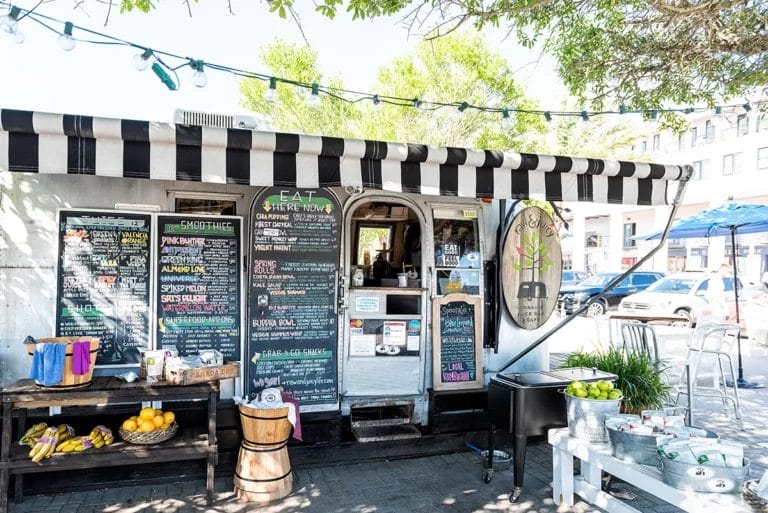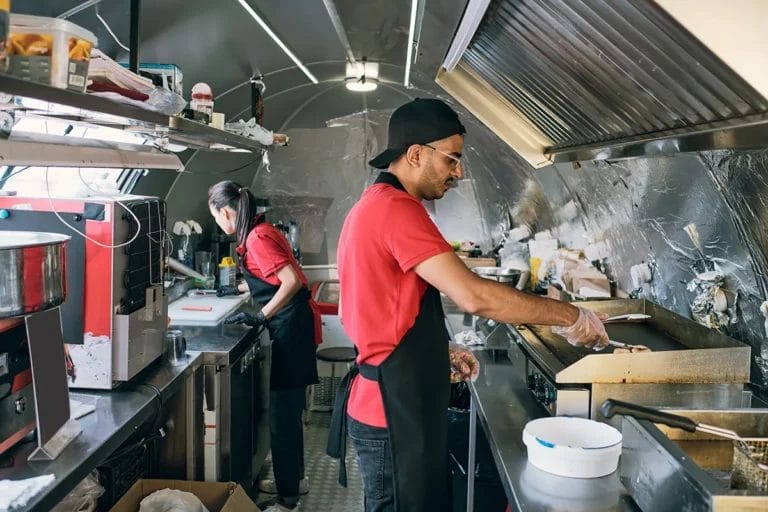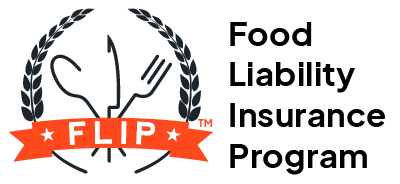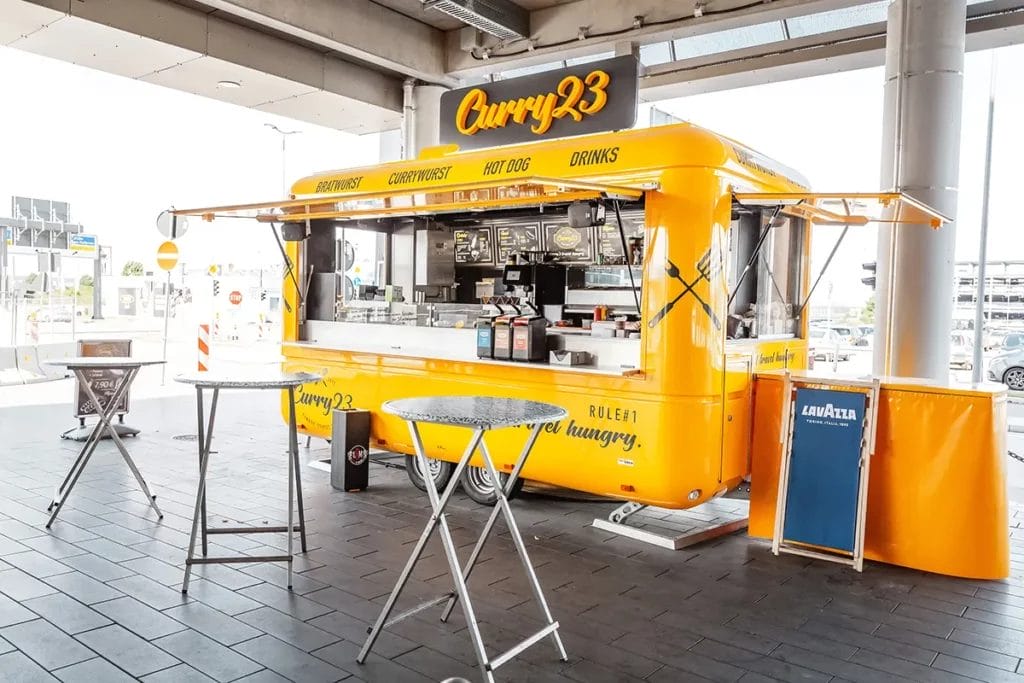1. Do Your Research
Knowledge is power when starting a mobile food business, so beginning with market research is critical to your success. This involves identifying a few key aspects of the market.
Your Competition
Look at other food trailer businesses in your area and similar businesses like food trucks you will compete against.
Answer these questions as you look into each competitor:
- What are they selling?
- How are they selling it?
- Who is their target customer?
- What is their unique value proposition (UVP)? In other words, which of their customers’ desires or needs do they satisfy, and how are they different from other mobile food businesses?
The State of the Food Trailer Business Industry
Your business won’t operate in a vacuum, so it’s essential to understand your local food trailer market landscape and plan around it.
Identify factors like:
- Growth: Is the food trailer business sector growing, staying flat, or shrinking in your area? Search “food trailer industry growth in [your city/state]” to find out. Analysts generally see growth in this sector across the U.S., with a mobile food business growth rate of 7.3% from 2024 to 2033.
- Emerging trends: Pay attention to what consumers are looking for from food trailers, such as how much they’re willing to spend per meal, what types of foods and flavors are in high demand, etc. Look at successful food trailer businesses in your area to help identify trends or check out food and beverage industry trend reports.
- Gaps in the market: What needs/desires aren’t being met by food trailer businesses in your area? This could include certain types of cuisine that are underrepresented or missing entirely, populous areas without many mobile food options, etc.
Ideal Locations
While food trailer businesses are increasingly popular nationwide, some cities or counties are more advantageous for these operations than others.
An ideal food trailer business location has the following:
- Foot traffic: Food trailers rely on pedestrian traffic to attract business. Target popular parks and bustling streets in highly populated areas. Office districts are also great for leveraging the lunch rush.
- Food trailer-friendly zoning laws: Some cities have strict regulations for mobile food businesses, limiting the length of time you can park in one place or charging high parking/licensing fees. Search for cities in your area that are less restrictive and expensive to operate within.
- Lively food festival scene: Food festivals are fantastic opportunities to gain exposure to a large, eager audience. Operating in an area known for hosting festivals and events with mobile food vendors fosters profitability for your business.
2. Develop Your Concept
The research you conducted in the first step pays off when you build your brand. Armed with a better understanding of what’s already out there, what gaps exist, and where you should operate, you’re ready to do the following:
- Name your business: Make your business name unique without making it difficult to understand or remember. Stick with a name that immediately tells customers what you sell but isn’t too similar to other businesses in your area, like Rolling Greens for a business specializing in salad bowls or Thrill of the Grill for a BBQ trailer.
- Design your logo: Your logo should be simple, easy to read, and recognizable. It should also incorporate your business colors. Create one yourself on Canva or hire a graphic designer.
- Create your menu: Chances are, you already have a good idea of what you want to sell, but now’s the time to envision what your menu will look like and what you will serve. Aim for 6–12 items to provide variety without overcomplicating menu options.
- Identify your target customer: This is an ongoing task, but start by surveying potential customers on social media (Instagram, Facebook groups, Reddit) to identify what people want to see from your business. Ask demographic questions in your survey to determine factors like age, location, and spending habits.
- Determine your UVP: Now that you better understand your competition, what value will you bring to customers that they don’t? This could be anything from your price point to the type of cuisine you sell.
3. Set Your Prices
While it’s crucial to consider what your competitors charge for similar products, don’t let this be the only determining factor. To price your menu items, identify the following:
- Your standard operating costs: These are dependable expenses you can anticipate, like trailer and vehicle maintenance, insurance premiums, licensing fees, and commercial kitchen requirements (if your state/county has a commissary mandate).
- The cost of your ingredients: Make a list of the ingredients you need to make each item on your menu and how much of each ingredient goes into each item. These expenses can fluctuate due to factors out of your control, like shortages, but do your best to estimate what you will typically spend per month on ingredients.
- Your desired profit margins: This varies depending on the type of food you sell and where you operate. As a reference point, the average food truck profit margin is 7–8%.
Using that information, determine the cost of each menu item using this formula:
Total Cost Per Serving ÷ (1 − Profit Margin) = Menu Price
2 ÷ (1 − 0.07) = $2.15
Pro Tip: Use a proven pricing strategy when deciding what to charge to maximize your profits and protect your margins!

4. Build Your Business Plan
Creating your business plan is a big undertaking, but it’s arguably the most important step in starting a food trailer business.
This plan details every aspect of your business while serving as a road map to growth. Potential investors and banks will ask to see your plan when you apply for funding, so it needs to be robust and professional.
Include the following sections in your food trailer business plan:
- Executive summary: A short, engaging description of your business meant to hook anyone reading it (investors, potential partners, etc.)
- Company description: An in-depth explanation of your business, including what you sell, where you operate, who your target customer is, and your UVP
- Market analysis: A breakdown of your competitors, target market, and where your business fits in within the broader food trailer landscape
- Marketing strategy: How you will promote your food trailer business and attract customers, including what channels you will use to reach them (e.g., social media platforms, paid ads, email newsletters, etc.)
- Loans and financing: What sources of funding you already have for your business and where you’re spending this money, as well as what funding you still need and how you intend to spend it
- Operational costs and financial projections: Your standard operating expenses and how they compare to your projected gross annual income
- Certificate of Insurance (COI): A document issued by your insurance provider proving what types of coverage you have and what your policy limits are
Our food trailer business plan template makes assembling your plan less intimidating by organizing these sections for you. Just enter information about your business and you’re ready to go!
5. Source Your Funding
Once your business plan is complete, you can apply for loans and/or grants to fund your operations.
Starting a food trailer business costs money, with food truck businesses spending an average of $100,000 for startup costs. However, there are many ways to finance your dream, and most entrepreneurs use a combination of the following to make it happen:
- Loans: Food trailers are the perfect candidate for microloans. The U.S. Small Business Administration (SBA) issues these loans of up to $50,000 to help entrepreneurs get their operations up and running. They have interest rate caps and are often easier to acquire than loans.
- Grants: Who doesn’t want money for their business they never have to pay back? While that does mean grants are highly competitive and challenging to get, don’t be discouraged from applying! Grants.gov and Hello Alice allow you to search and apply for grants online.
- Investors: For a stake in your business and a cut of your profits, investors provide you with money if they like your business plan and feel confident about the financial future of your operations.
- Crowdfunding: Friends, loved ones, and generous strangers may be incentivized to donate money to your business if you offer perks in exchange, such as discounts or freebies. Set up a fundraiser on Kickstarter and GoFundMe and share it on social media.
- Personal finances: While it’s unrealistic for most people to finance their business using only personal funds, expect to dedicate some of your money to it. Any money you invest in your business is money you don’t have to pay back with interest!
6. Buy Your Trailer
Your trailer is the hub of your business and one of your most significant startup costs, so choosing the right one is key. Here are a few tips for picking out the perfect trailer:
- Determine your budget: Knowing how much money you can spend on this expense will narrow your options and prevent you from wasting time looking at trailers you can’t afford. Buying used instead of new is a smart way to save — just make sure you get one in good shape.
- Consider the space you need: The size of your food trailer depends on how much room you need for food prep, storage, and equipment. If you need to fit a stovetop and a fridge in your trailer, you need a bigger trailer than someone who does all their food prep outside of their trailer.
- Understand the features of different trailer types: Gooseneck trailers are better for carrying heavier loads and attach to a hitch mounted on your truck bed. Bumper trailers have a lower weight capacity but are generally easier to maneuver and attach to a wider variety of vehicles.
If you don’t already have one, you’ll need a vehicle equipped to tow your food trailer. Pickup trucks are popular because they are compatible with most trailers, but SUVs are a solid choice if you have a bumper trailer.
7. Get Other Essential Equipment
- Point-of-sale (POS) system
- Generator
- Propane tanks
- Water tanks
- Grill/griddle
- Oven, stovetop, and/or deep fryer
- Refrigerator
- Freezer
- Insulated food containers
- Storage shelve
- Ventilation hood
- Three-compartment sink
- Handwashing sink
- Fire extinguisher(s)
- First aid kit
- Menu boards
- Condiment containers/dispensers
- Spatulas
- Knives
- Cutting boards
- Pots and pans
- Mixing bowls
- Measuring cups/spoons

8. Acquire Necessary Licenses, Permits, and Insurance
Before you hit the road and start serving customers, determine what permits are needed for a food trailer in your area. These requirements are typically set by city or county governments and can vary widely across the country, but expect to need this documentation:
- Business license: You can often register your business through your city or county government clerk’s website. Keep in mind, there may be a recurring annual fee to maintain this license.
- Health department permit: This is usually obtained once you pass a health inspection conducted by local officials.
- Sales tax permit: Allows you to collect and remit sales tax on any taxable products you sell.
- Employer Identification Number (EIN): This is a social security number for your business, obtained through the Internal Revenue Service (IRS) and used for tax purposes.
- Fire certificate: Following a successful safety inspection, your local fire department may issue this certificate to show that your trailer is up to code.
- Commissary agreement: Many local governments require mobile food businesses to rent a commissary kitchen where they must prepare and/or store all the food they sell.
- Vehicle licenses: You must obtain licenses for both your towing vehicle and your trailer issued by your state’s department of motor vehicles.
- Insurance: Not only do you need commercial auto insurance for your food trailer and towing vehicle, but you also need liability insurance in case you’re held liable for injuries or property damage caused by your business.
Speaking of insurance, most food business liability policies don’t cover accidents that happen in, on, or around your food trailer. Because your trailer is considered a commercial auto, general liability insurance will not cover any claims involving it.
But with FLIP’s food trailer insurance, you can get coverage for these incidents! Our exclusive Food Trailer Endorsement extends your general liability coverage to your food trailer, closing a huge coverage gap and creating a financial safety net in case something goes awry.
Learn more about our food trailer insurance and discover how this one-of-a-kind coverage can save you thousands in claims while granting access to more events and vending opportunities!
9. Develop a Marketing Strategy
Website Search Engine Optimization (SEO)
Every business needs a visually appealing, easy-to-navigate website. For food businesses, this is critical — 32% of customers always check a restaurant’s website before visiting, with 51% sometimes checking beforehand.
An attractive website isn’t enough to put you on the first page of Google search results. To do that, your site must follow SEO best practices.
If you created your site through a builder like Squarespace or Wix, use their integrated SEO tools. These tools help you identify which keyword phrases people use to find your site (e.g., “taco trailer Burlington”) and identify where you can use them.
The more often your site appears in the top search results, the more people will see it and be enticed to try your food trailer.
Pro Tip: Not interested in DIY? Hire a professional web designer on a platform like Fiverr to build and optimize your site.
Social Media
Social media is a great marketing tool because you can gain a following and build hype for your business without paying a cent. But when you want to spend money on ads, it’s easy to turn your posts into paid promotions so they appear in local users’ feeds.
Some of the best platforms for food businesses include:
- TikTok
- X (formerly Twitter)
Post mouthwatering pictures of your food, behind-the-scenes glimpses, and even short daily updates to connect with current and prospective customers.
Don’t forget to keep your branding consistent across all platforms! Your logo, brand colors, and brand voice (the way you speak to your customers) should be the same no matter where you post. Consistent branding makes customers confident they know your business and enhances your legitimacy.
Pro Tip: Our guide to promoting your food business on Instagram is chock-full of tips and ideas you can start using today!
Traditional Advertising
Digital marketing is huge, but don’t write off traditional forms of advertising. Marketing materials that seem old-fashioned are still highly effective for local businesses, such as:
- Direct mail (flyers, postcards, coupons, etc.)
- Radio ads
- Local newspaper ads
- Sponsoring community events
- Branded merchandise (stickers, T-shirts, hats, etc.)
- Branded packaging
- Branded trailer wrap (should include your logo, brand colors, and social media handles)
- A-frame signs to display curbside at your next event/wherever you sell
Word-of-Mouth Marketing
90% of people are more likely to buy from a business recommended by someone they trust versus buying because of any other form of promotion. While not surprising, the key takeaway is that you’re missing out on a lot of potential revenue if you aren’t generating word-of-mouth for your food trailer business.
Some of the best ways to build hype and get customers to recommend you include:
- Offer exceptional customer service: When someone is dissatisfied with their food, don’t hesitate to provide a refund and replace their dish. If you have repeat customers, try remembering their names and orders. These small gestures add up and create a memorable experience they want to share.
- Incentivize reviews: Ask happy customers to leave reviews of your business on Google and Yelp. To sweeten the deal, offer a free drink or discount with their next purchase.
- Share user-generated content (UGC): Encourage customers to share pictures of their order on social media and tag you for a chance to win a discount or freebie. When they tag you, repost it on your account.
Ranked best insurance for food trailers by Investopedia
FAQs About Starting a Food Trailer Business
What Type of Food Should I Sell From My Food Trailer?
The type of food you sell should depend on these factors:
- Your personal interests/culinary skillset
- What’s easiest to serve from your trailer
- Your target audience’s interests
- Your budget
No matter what you sell, provide options for people with dietary restrictions, such as vegetarian substitutions or gluten-free items. Consumer interest in health-conscious options is rising, so you can attract more customers with these options.
What Are Common Challenges for Food Trailer Businesses?
- Local zoning laws: Each city has regulations affecting where and how long you can park, making it difficult for mobile food businesses to operate around
- Weather: Because food trailer businesses rely heavily on foot traffic, bad weather can negatively affect sales
- Fluctuating ingredient costs: Global shortages and extreme weather can decrease the supply and unexpectedly drive up the cost of your ingredients
- Equipment breakdowns: Relying on vehicles to run your business requires you to invest in regular truck and trailer maintenance.

Alex Hastings
Seattle-based copywriter and (WA) licensed insurance agent Alex Hastings leverages her experience as a lover of fast-casual food, baked goods, and iced oat milk lattes. She holds a B.A. in Creative Writing from Western Washington University. Before working at Veracity, she was a retail copywriter at Zulily and an English language teacher in South Korea. Alex is fully trained on FLIP insurance coverages and writes content that connects food and beverage business owners with the policies they need.
Seattle-based copywriter and (WA) licensed insurance agent Alex Hastings leverages her experience as a lover of fast-casual food, baked goods, and iced oat milk lattes. She holds a B.A. in Creative Writing from Western Washington University. Before working at Veracity, she was a retail copywriter at Zulily and an English language teacher in South Korea. Alex is fully trained on FLIP insurance coverages and writes content that connects food and beverage business owners with the policies they need.

Kyle Jude
Kyle Jude is the Program Manager for Food Liability Insurance Program (FLIP). As a dedicated program manager with 10+ years of experience in the insurance industry, Kyle offers insight into different coverages for food and beverage business professionals who are looking to navigate business liability insurance.
Kyle Jude is the Program Manager for Food Liability Insurance Program (FLIP). As a dedicated program manager with 10+ years of experience in the insurance industry, Kyle offers insight into different coverages for food and beverage business professionals who are looking to navigate business liability insurance.

